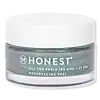What's inside
What's inside
 Key Ingredients
Key Ingredients

 Benefits
Benefits

 Concerns
Concerns

 Ingredients Side-by-side
Ingredients Side-by-side

Water
Skin ConditioningKaolin
AbrasiveBentonite
AbsorbentGlycerin
HumectantAcacia Senegal Gum
MaskingXanthan Gum
EmulsifyingBenzyl Alcohol
PerfumingAlcohol
AntimicrobialSodium Dehydroacetate
PreservativeCI 77491
Cosmetic ColorantCitrus Aurantium Bergamia Fruit Oil
MaskingVitis Vinifera Fruit Extract
Skin ConditioningLimonene
PerfumingLavandula Angustifolia Oil
MaskingLinalool
PerfumingSodium Citrate
BufferingCitric Acid
BufferingDehydroacetic Acid
PreservativeCoffea Arabica Seed Extract
MaskingCoffea Robusta Seed Extract
Skin ConditioningCarbomer
Emulsion StabilisingCupressus Sempervirens Oil
MaskingSalvia Sclarea Oil
MaskingCI 77499
Cosmetic ColorantCommiphora Myrrha Oil
MaskingSantalum Album Oil
MaskingAnthemis Nobilis Flower Oil
MaskingPapain
Skin ConditioningPetroselinum Crispum Seed Oil
Masking1,2-Hexanediol
Skin ConditioningCaprylyl Glycol
EmollientSodium Benzoate
MaskingLactic Acid
BufferingAlgin
MaskingPotassium Sorbate
PreservativeWater, Kaolin, Bentonite, Glycerin, Acacia Senegal Gum, Xanthan Gum, Benzyl Alcohol, Alcohol, Sodium Dehydroacetate, CI 77491, Citrus Aurantium Bergamia Fruit Oil, Vitis Vinifera Fruit Extract, Limonene, Lavandula Angustifolia Oil, Linalool, Sodium Citrate, Citric Acid, Dehydroacetic Acid, Coffea Arabica Seed Extract, Coffea Robusta Seed Extract, Carbomer, Cupressus Sempervirens Oil, Salvia Sclarea Oil, CI 77499, Commiphora Myrrha Oil, Santalum Album Oil, Anthemis Nobilis Flower Oil, Papain, Petroselinum Crispum Seed Oil, 1,2-Hexanediol, Caprylyl Glycol, Sodium Benzoate, Lactic Acid, Algin, Potassium Sorbate
Water
Skin ConditioningGlycolic Acid
BufferingSaccharomyces Ferment
Skin ConditioningGlycerin
HumectantSolanum Tuberosum Starch
AbsorbentArginine
MaskingPropanediol
SolventSodium Hydroxide
BufferingSalicylic Acid
MaskingSpirulina Platensis Extract
Skin ProtectingVitis Vinifera Fruit Extract
Skin ConditioningSilica
AbrasiveLactobacillus Ferment
Skin ConditioningSclerotium Gum
Emulsion StabilisingHydroxyacetophenone
AntioxidantCaprylyl Glycol
Emollient1,2-Hexanediol
Skin ConditioningTrisodium Ethylenediamine Disuccinate
Tin Oxide
AbrasiveSynthetic Fluorphlogopite
Mica
Cosmetic ColorantCI 77891
Cosmetic ColorantCI 77510
Cosmetic ColorantCI 77492
Cosmetic ColorantWater, Glycolic Acid, Saccharomyces Ferment, Glycerin, Solanum Tuberosum Starch, Arginine, Propanediol, Sodium Hydroxide, Salicylic Acid, Spirulina Platensis Extract, Vitis Vinifera Fruit Extract, Silica, Lactobacillus Ferment, Sclerotium Gum, Hydroxyacetophenone, Caprylyl Glycol, 1,2-Hexanediol, Trisodium Ethylenediamine Disuccinate, Tin Oxide, Synthetic Fluorphlogopite, Mica, CI 77891, CI 77510, CI 77492
Ingredients Explained
These ingredients are found in both products.
Ingredients higher up in an ingredient list are typically present in a larger amount.
1,2-Hexanediol is a synthetic liquid and another multi-functional powerhouse.
It is a:
- Humectant, drawing moisture into the skin
- Emollient, helping to soften skin
- Solvent, dispersing and stabilizing formulas
- Preservative booster, enhancing the antimicrobial activity of other preservatives
Caprylyl Glycol is a humectant and emollient, meaning it attracts and preserves moisture.
It is a common ingredient in many products, especially those designed to hydrate skin. The primary benefits are retaining moisture, skin softening, and promoting a healthy skin barrier.
Though Caprylyl Glycol is an alcohol derived from fatty acids, it is not the kind that can dry out skin.
This ingredient is also used as a preservative to extend the life of products. It has slight antimicrobial properties.
Learn more about Caprylyl GlycolGlycerin is already naturally found in your skin. It helps moisturize and protect your skin.
A study from 2016 found glycerin to be more effective as a humectant than AHAs and hyaluronic acid.
As a humectant, it helps the skin stay hydrated by pulling moisture to your skin. The low molecular weight of glycerin allows it to pull moisture into the deeper layers of your skin.
Hydrated skin improves your skin barrier; Your skin barrier helps protect against irritants and bacteria.
Glycerin has also been found to have antimicrobial and antiviral properties. Due to these properties, glycerin is often used in wound and burn treatments.
In cosmetics, glycerin is usually derived from plants such as soybean or palm. However, it can also be sourced from animals, such as tallow or animal fat.
This ingredient is organic, colorless, odorless, and non-toxic.
Glycerin is the name for this ingredient in American English. British English uses Glycerol/Glycerine.
Learn more about GlycerinVitis Vinifera Fruit Extract comes from grapes.
Grape extract has many skin benefits. It also contains many potent antioxidants such as Vitamin E , Vitamin C, proanthocyanidins, polyphenols, flavonoids, and anthocyanins. Antioxidants help protect skin. Proanthocyanidin have also been shown to help even out skin tone.
Grape extract also helps soothe and hydrate your skin.
Learn more about Vitis Vinifera Fruit ExtractWater. It's the most common cosmetic ingredient of all. You'll usually see it at the top of ingredient lists, meaning that it makes up the largest part of the product.
So why is it so popular? Water most often acts as a solvent - this means that it helps dissolve other ingredients into the formulation.
You'll also recognize water as that liquid we all need to stay alive. If you see this, drink a glass of water. Stay hydrated!
Learn more about Water